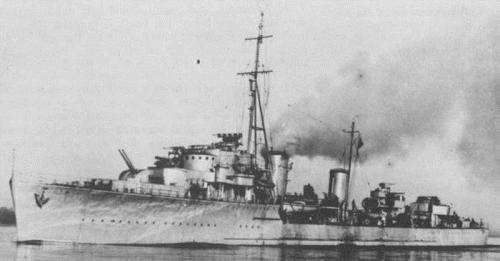
NAVYPEDIA
 Support the project with paypal
Support the project with paypal
Photo

Isaac Sweers Many thanks to Wolfgang Stöhr for additional information on this page.
Ships
| Name | No | Yard No | Builder | Laid down | Launched | Comp | Fate |
|---|---|---|---|---|---|---|---|
| Gerard Callenburgh | 208 | Rotterdamsche Droogdok Mij, Rotterdam | 10.1938 | 12.10.1939 | 10.1942 // --- | scuttled incomplete15.5.1940, completed as German ZH1 | |
| Isaac Sweers | G83 | 212 | De Schelde, Vlissingen / Thornycroft, Southampton, UK | 11.1938 | 16.3.1940 | 3.1941 | sunk 13.12.1942 |
| Tjerk Hiddes | 213 | Roterdamsche Droogdok Mij, Rotterdam | 11.1938 | 12.10.1939 | --- | scuttled incomplete 14.5.1940 | |
| Philips van Almonde | 213 | De Schelde, Vlissingen | 3.1939 | --- | --- | demolished on the stocks 17.4.1940 |
Technical data
| Displacement standard, t | 1604 |
|---|---|
| Displacement full, t | 2228 |
| Length, m | 105.0 wl 107.0 oa |
| Breadth, m | 10.6 |
| Draught, m | 2.80 |
| No of shafts | 2 |
| Machinery | 2 sets Parsons geared steam turbines, 3 Yarrow boilers |
| Power, h. p. | 45000 |
| Max speed, kts | 36 |
| Fuel, t | oil 560 |
| Endurance, nm(kts) | 5400(19) |
| Armament | as designed: 2 x 2 - 120/45 Wilton-Fijenoord No.8, 1 x 1 - 120/45 Wilton-Fijenoord No.8, 2 x 2 - 40/56 Bofors No.3, 2 x 2 - 12.7/62, 2 x 4 - 533 TT, 4 DCT (12), 24 mines, 1 seaplane (C.XIW) Isaac Sweers: 3 x 2 - 102/45 QF Mk XVI, 2 x 2 - 40/56 Bofors No.3, 2 x 4 - 12.7/62, 2 x 4 - 533 TT, 4 DCT (12), 24 mines |
| Electronic equipment | Isaac Sweers: type 124 sonar |
| Complement | 158 Isaac Sweers: 194 |
Standard scale images

Tjerk Hiddes as designed

Isaac Sweers 1941

Isaac Sweers 1941
Graphics
Project history
In the mid-thirties, in connection with growth of threat from Japan, the Dutch Government has found means for building of 4 modern destroyers. As commissioned destroyers of "Admiralen" type have been insufficiently armed, for new ships the thrust became on increasing of dimensions and fire power, and it dared, not in the last instance, at the expense of advanced fire control system and qualitative enhancement of air defence weapons. Gerard Callenburgh and Tjerk Hiddes have been ordered under the 1937 program, Isaak Sweers and Philips van Almonde next year.
Gerard Callenburgh class destroyers were again projected by means of Yarrow and had increased approximately on 300t displacement. Increased dimensions have allowed to strengthen armament by one more 120mm gun, and also for the first time in Dutch fleet to mount quadruple 533mm TT. Artillery took places under the original scheme: fore and aft there were twin turret mounts (with placing of guns in common gun slide), and single gun mount on a stern superstructure. As well as in the previous designs, ability of carrying of a seaplane was kept, seaplane was placed between funnels not to eclipse fire angle of aft 40mm MG and a derrick for seaplane handling was installed at fore funnel.
Engine power in comparison with previous "Admiralen" type has increased by 45%; the endurance also was significantly increased. On trials Isaak Sweers has shown 37.5kts speed.
Isaac Sweers 10-12.5.1940 was been towed off to the Great Britain and was completed by Thornycroft at Southampton under the changed design. Incomplete Gerard Callenburgh was scuttled at Rotterdam 15.5.1940; she was salvaged by German wreckers 17.7.1940 and after repair 11.10.1942 was commissioned by Kriegsmarine as ZH1, she was lost 9.6.1944. Incomplete Tjerk Hiddes was scuttled 14.5.1940; she was salvaged by German wreckers 12.6.1940, renamed ZH2, but never completed and later scrapped. Philips van Almonde was blown up on a slipway 17.4.1940 (under some sources she received German name ZH3).
Modernizations 9.
1942, Isaac Sweers: - 2 x 4 - 12.7/62; + 4 x 1 - 20/70 Oerlikon Mk II/IV
Naval service
Isaac Sweers was sunk 13.12.1942 by German submarine U431 at coast of Algeria.
Many thanks to Wolfgang Stöhr for additional information on this page.
 HOME
HOME FIGHTING SHIPS OF THE WORLD
FIGHTING SHIPS OF THE WORLD NETHERLANDS
NETHERLANDS TORPEDO SHIPS
TORPEDO SHIPS GERARD CALLENBURGH destroyers (1941)
GERARD CALLENBURGH destroyers (1941)
